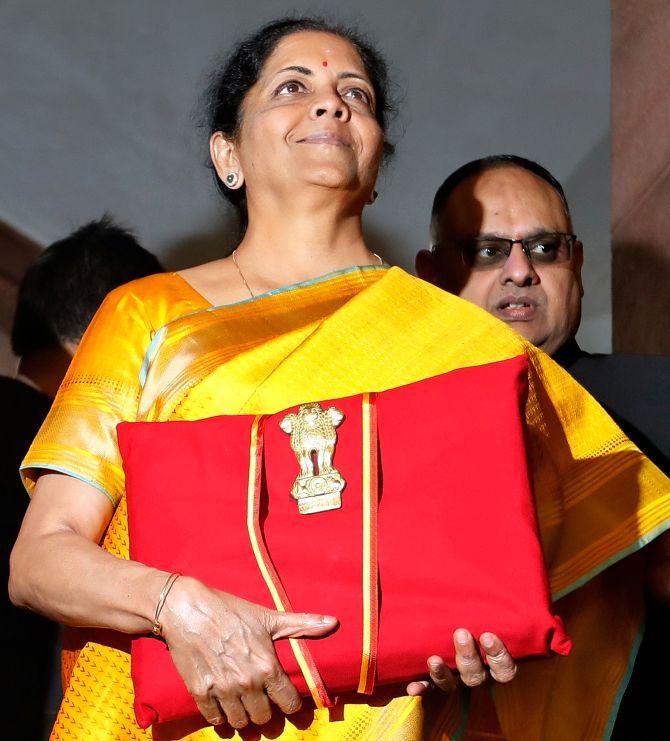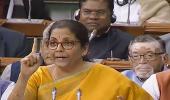The immediate need is to put more money in the hands of agriculture-based and rural households to improve their purchasing power, says S Mahendra Dev.

The Indian economy has been slowing down in the last few years.
Both the agriculture and the rural non-farm sector have been under distress.
The agricultural GDP growth rate declined from 5 per cent in 2017-18 to 2.9 per cent in 2018-19, and 2.8 per cent in 2019-20. In fact, it was 2 per cent and 2.1 per cent in Q1 and Q2 of 2019-20 respectively.
The growth rate of wages was also very low in the last few years.
The overall economic slowdown was partly because of low incomes and the lack of demand in rural areas.
Therefore, one expected a big push and bold measures for agriculture and rural areas.
The Budget, however, has not explicitly recognised the crisis at either the economy level or in agriculture and the rural sector.
The 16-action points for agriculture, irrigation and rural development presented by the finance minister are a step in the right direction.
These proposals cover model laws on marketing, solar power generation, warehousing, cold storage, the horticulture sector, integrated farming systems, livestock, blue economy, self-help groups etc.
But these proposals may not be enough to revive Indian agriculture and the rural areas.
The success of these proposals also depends on how they are going to be implemented.
The Budget indicates that the Centre would encourage those state governments that undertake the implementation of model laws already issued by the central government.
Farmers want freedom.
The Economic Survey talks about the need for the removal of the Essential Commodities Act (ECA) as the frequent and unpredictable imposition of blanket stock limits on commodities neither brings down prices nor reduces price volatility.
Similarly, banning exports hurt farmers the most.
There is a need for a consistent long-term policy on exports and futures markets.
The Budget is silent on the ECA and push to agricultural exports.
It also did not mention food and fertiliser subsidies.
The Budget allocates Rs 71,000 crore for fertiliser subsidies and Rs 1.16 trillion for food subsidies.
We also have off-Budget allocations on these two subsidies.
It is better to introduce the direct benefit transfer system in fertilisers.
Linking pump sets to solar energy and the scheme to enable farmers to set up solar power generation capacity on their fallow/barren land are good measures.
It also helps achieve the goal of doubling farm incomes.
It seems China is using this mechanism to increase agricultural income in a big way. India can also explore solar power generation by farmers even on normal land without disturbing crop production.
The focus on warehousing, cold supply chains, and adopting cluster basis for horticulture are good measures to augment incomes.
Farmers should get remunerative prices for their production.
The Economic Survey mentions "Thalinomics" and says the price of a thali has declined.
This has helped both rural and urban consumers.
It may be noted that farmers are getting lower incomes because of low food prices.
Probably the Economic Survey has not recognised this point.
The immediate need is to put more money in the hands of agriculture-based and rural households to improve their purchasing power.
It should have increased allocations to the MGNREGA, PM-KISAN and rural infrastructure to raise incomes in rural areas.
There was a reduction in the allocation to the MGNREGA from Rs 71,000 crore (RE) in 2019-20 to Rs 61,500 crore (BE) in 2020-21.
The allocation to PM-KISAN in 2020-21 (BE) is Rs 75,000 crore.
States are not able to disburse probably because of the absence of land records.
Of course, these are short-term cyclical measures and these should be accompanied by structural reforms for higher growth in agriculture and in rural development.
Some of the measures and allocations on Aspirational India, Economic Development and Caring Society will also help agricultural and rural families.
Big investments are needed for rural infrastructure.
Under the national infrastructure pipeline, the government is planning to invest Rs 103 trillion in the next five years.
Some of it should go to agriculture and rural infrastructure.
To conclude, the 16-action points are somewhat better than last year's Budget announcements.
But one expected bold measures in the context of the agriculture and rural distress.
The Budget mentions state governments only in the case of the Centre’s model laws on marketing and on the land leasing Act.
Agriculture is a state subject.
The central government has to work closely with states to revive agriculture and the rural sector with the goals of achieving higher growth, inclusiveness, and sustainability.
S Mahendra Dev is vice-chancellor, IGIDR.
Photograph: Altaf Hussain/Reuters












 © 2025
© 2025